How to Dry Silk Pillowcase
To dry your silk pillowcase properly, start by gently blotting excess moisture with a clean, dry towel – never wring or twist the fabric. You'll want to air dry the pillowcase indoors, away from direct sunlight to prevent fading and fiber damage. Lay it flat on a clean towel in a well-ventilated area between 60-75°F, or hang it on a padded hanger. Smooth out any wrinkles with your hands during the drying process. While you can use a dryer's no-heat setting, air drying remains the safest method for preserving your silk's texture and integrity. The following methods will help maximize your pillowcase's longevity.
This post may contain affiliate links. If you make a purchase through these links, I may earn a commission at no additional cost to you. Additionally, portions of this post may be generated using artificial intelligence (AI) technology. While we strive for accuracy, please be aware that AI-generated content may not always be perfect and should be fact-checked when necessary.
The Spatula Scoops
- Gently blot excess moisture with a clean towel without wringing or twisting the silk fabric to maintain its integrity.
- Air dry indoors in a well-ventilated area away from direct sunlight to prevent color fading and fiber damage.
- Lay the pillowcase flat on a clean towel and smooth out wrinkles with your hands while drying.
- Use padded hangers or wide-bar clotheslines if hanging to dry, ensuring proper air circulation around the fabric.
- Avoid using a dryer with heat, but if necessary, only use the no-heat air-dry setting to protect the silk.
Best Drying Methods for Silk
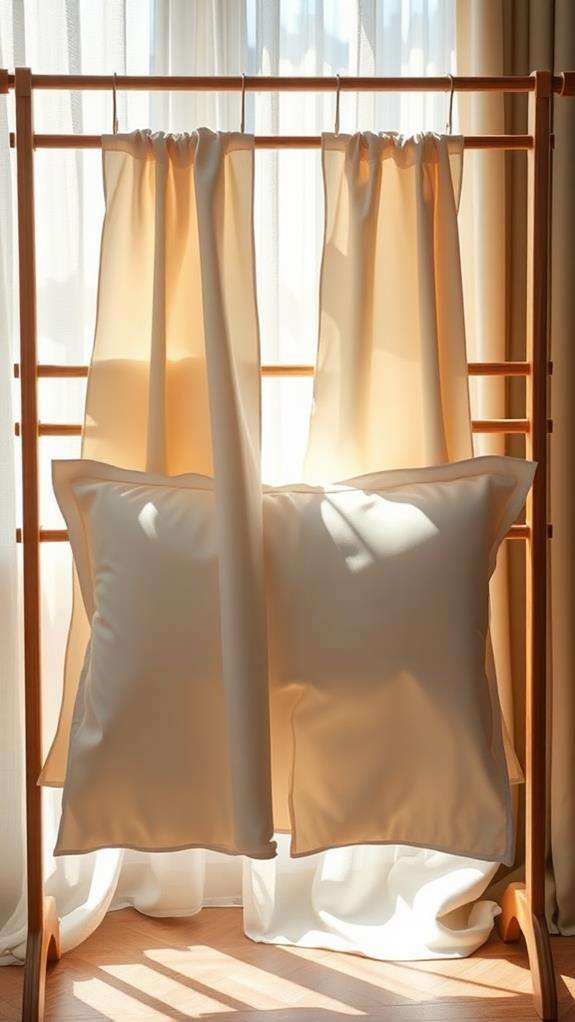
When caring for silk pillowcases, choosing the right drying method is essential for maintaining their luxurious feel and extending their lifespan.
To dry silk pillowcases properly, you'll want to start by gently blotting excess moisture with a clean, dry towel. Don't wring or twist the fabric, as this can compromise the integrity of the fibers. The most effective way to air dry your silk pillowcase is to hang it indoors, away from direct sunlight that could cause unwanted fading. Your pillowcase should be completely dry within about an hour using this method. If you're concerned about wrinkles, you can lay the pillowcase flat on your bed and smooth it out with a slightly damp bedsheet while it dries. For those times when you absolutely must use a dryer, remember to only use the no heat setting to prevent damage to the delicate silk fibers. This slower, gentler approach to drying will help prevent wrinkles and maintain the fabric's natural sheen. While it might take a bit more time than tossing it in the dryer, proper drying techniques will greatly extend your silk pillowcase's life.
Air Drying Your Silk Pillowcase
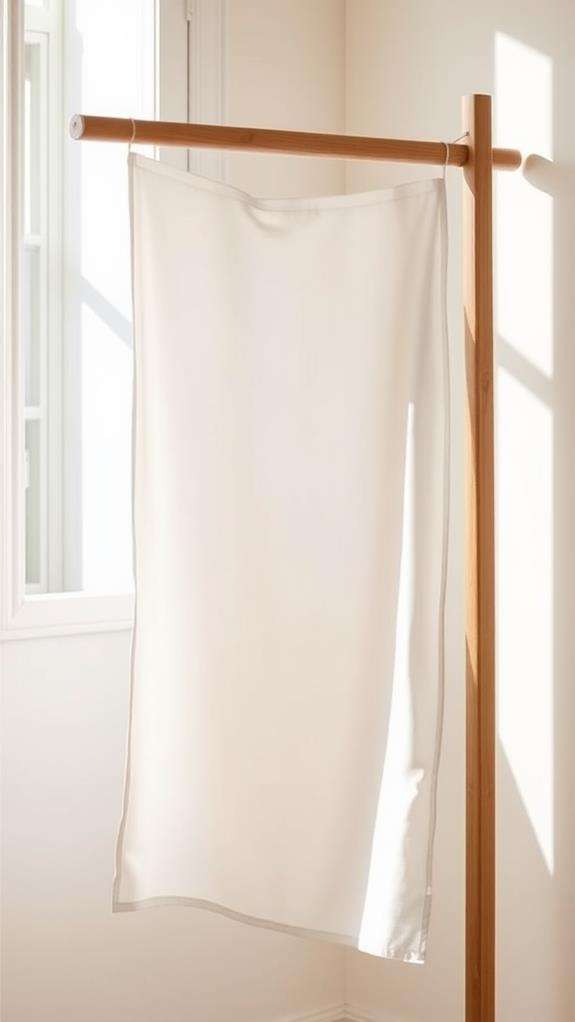
When air drying your silk pillowcase, you'll want to select a well-ventilated indoor location away from direct sunlight, such as a drying rack in your laundry room or a clean hanger in your closet. To prevent unsightly wrinkles from forming, gently smooth out the fabric with your hands before laying it flat on a clean, white towel, making sure all edges are properly aligned. You can also hang your silk pillowcase on a padded hanger, ensuring it's evenly distributed to maintain its shape while drying.
Optimal Air Drying Locations
The perfect spot for drying your silk pillowcase can make all the difference in preserving its quality. You'll want to choose an indoor location that's well-ventilated but away from direct sunlight, as UV rays can fade and weaken the delicate silk fibers. Select a cool, shaded area in your home where air can freely circulate around the fabric.
Set up your drying station using a sturdy clothesline or a wide-bar hanger that'll support the pillowcase's shape while allowing proper air circulation. If you need to secure the silk pillowcase, opt for soft grip clothespins instead of metal ones that could snag or damage the material. Keep in mind that high-humidity areas, like bathrooms or basements, aren't suitable as they can promote mildew growth in your silk fabric. Instead, choose a bedroom or living room with good airflow. To speed up the drying process, you can position a fan nearby, but don't aim it directly at the pillowcase. This gentle air movement will help moisture evaporate more efficiently while protecting the fabric's delicate fibers.
Preventing Wrinkles While Drying
Keeping your silk pillowcase wrinkle-free during the drying process requires careful attention to detail, just like choosing the right drying location. To prevent wrinkles while air drying your silk pillowcase, you'll need to start by laying the pillowcase flat on a clean, dry towel to absorb excess moisture.
When handling your wet silk pillowcase, avoid twisting or wringing it out, as this can damage the delicate fibers and create unwanted creases. Instead, gently press the towel around the fabric to remove water. Once you've removed most of the moisture, hang your pillowcase in a spot that's away from sunlight and heat sources to reduce fading and maintain the silk's natural luster. You'll want to use soft grip hangers or gentle clothespins that won't leave marks on the fabric while it dries. Throughout the drying process, take time to smooth the silk with your hands, working from top to bottom to release any potential wrinkles. This gentle manipulation of the fabric helps guarantee your pillowcase dries without stubborn creases that might be difficult to remove later.
Avoid Direct Sunlight
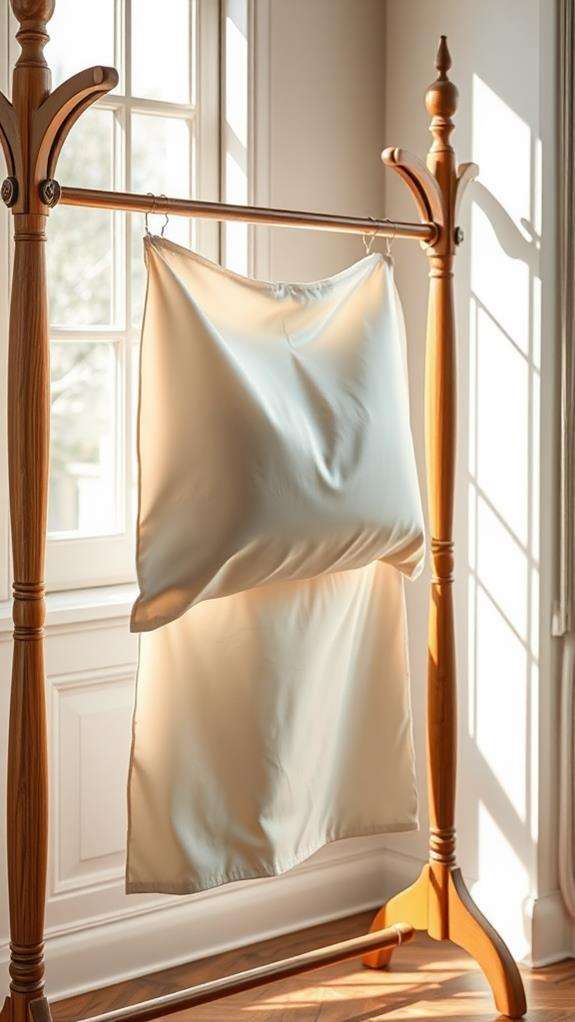
Protecting your silk pillowcase from direct sunlight is essential during the drying process. When silk fabrics are exposed to UV rays, they can quickly lose their vibrant color and become discolored, which will diminish the luxurious appearance you've invested in. Additionally, sunlight breaks down the delicate silk fibers, compromising their strength and reducing your pillowcase's lifespan.
To preserve the integrity of your silk pillowcase, you'll want to air dry it in a shaded indoor area, such as a laundry room or bedroom. If you must dry your pillowcase outdoors, choose a covered space like a porch or balcony that's protected from direct sunlight. You can also cover silk items with a light-colored cloth while they're drying to provide an extra barrier against harmful UV rays. This simple step will help maintain the natural luster and sheen that makes silk so desirable.
Using a Clean Towel
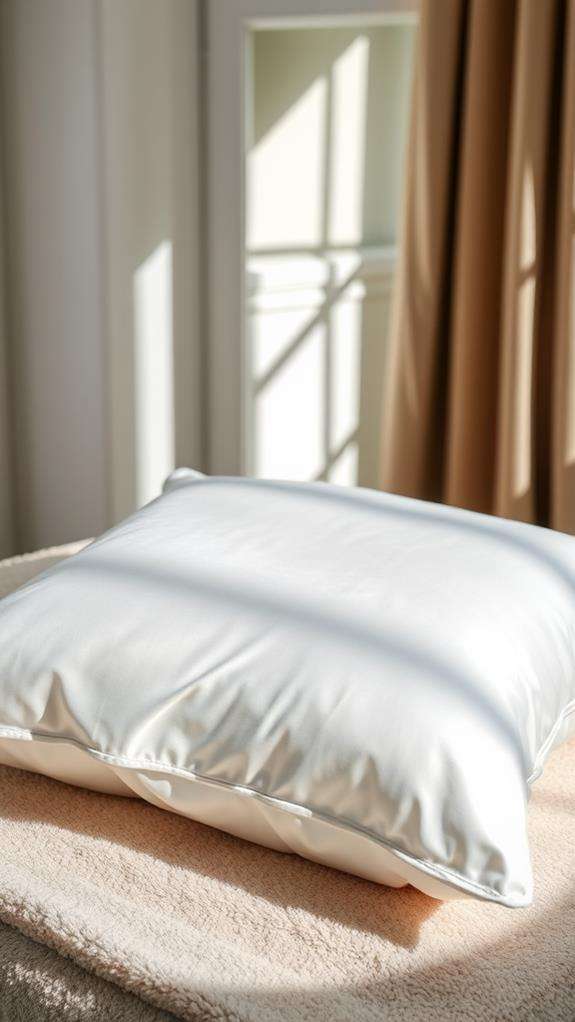
When drying your silk pillowcase, proper towel technique makes all the difference in preserving its delicate fibers. Using a clean towel correctly helps remove excess moisture while protecting the silk's natural sheen and structure. To guarantee your pillowcase maintains its quality, follow these essential steps for towel-drying:
- Gently press a clean, dry towel against the silk to blot moisture, avoiding any rubbing or wringing motions that could damage the fabric
- Roll the pillowcase between two clean towels, applying light pressure to absorb water without stretching the material
- Lay the pillowcase flat on a fresh towel or drying rack, smoothing out any wrinkles or folds
- Position the drying setup in a shaded area away from direct sunlight to prevent fabric degradation
After the initial towel-drying process, you'll want to guarantee your pillowcase is completely dry before use or storage. Even slight dampness can lead to mildew, which could permanently damage your silk. If you're using a drying rack, maintain good air circulation around the pillowcase. Remember to occasionally rotate the pillowcase to guarantee even drying on both sides.
Indoor Vs Outdoor Drying
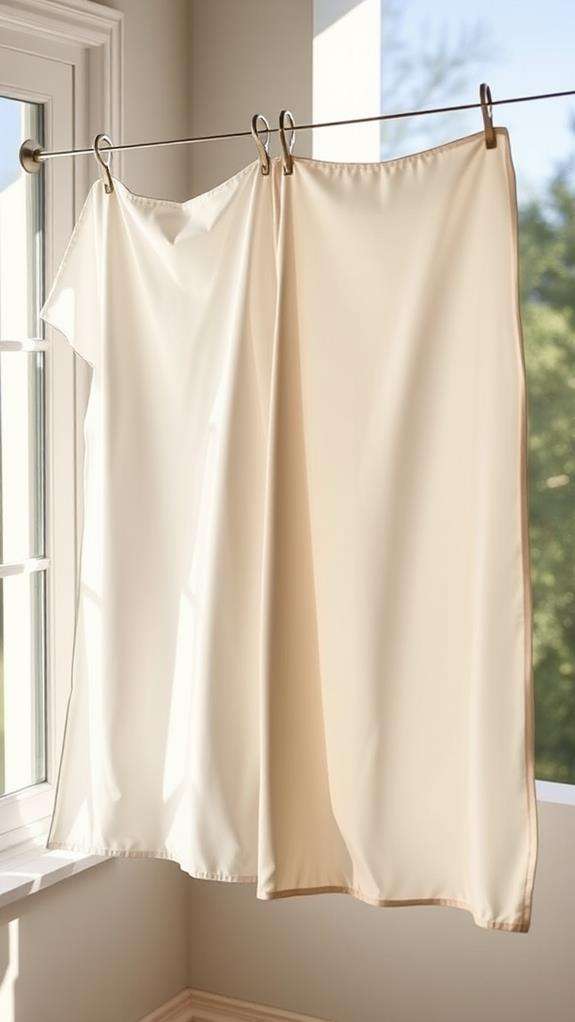
When choosing between a shaded porch and indoor spaces for drying your silk pillowcase, you'll need to weigh the benefits of each location's airflow characteristics. Your shaded porch can offer excellent ventilation while protecting the silk from direct sunlight, but indoor spaces like a sunroom, basement, or living area give you more control over environmental factors such as dust and unexpected weather changes. If you're using an indoor space, you'll want to select an area with good air circulation, preferably near a window or fan, while keeping the pillowcase away from direct sunlight that might stream through the glass.
Shaded Porch Vs Sunroom
The choice between a shaded porch and a sunroom for drying your silk pillowcase depends on your local climate and available space. A shaded porch offers natural air circulation while protecting your silk from direct sunlight, helping maintain the fabric's quality and preventing unwanted fading. Meanwhile, a sunroom provides a more controlled environment with consistent temperature and humidity levels.
When deciding between these two options, consider these key factors:
- Sunrooms offer protection from unexpected weather changes and maintain steady drying conditions
- Shaded porches provide better air circulation, which can speed up the drying process
- Direct sunlight exposure is easier to control in a sunroom through blinds or curtains
- Outdoor environments may introduce dust or debris that could affect your silk's finish
If you're using a sunroom, position your silk pillowcase away from windows where direct sunlight streams in. For porch drying, hang your pillowcase in the shadiest area available, ensuring good airflow without exposure to harsh sunlight. In both locations, remember to lay your pillowcase flat or hang it gently without wringing or twisting the fabric, as this can damage the delicate silk fibers.
Basement or Living Area
Since controlling temperature and humidity is crucial for silk care, choosing between your basement and living area for indoor drying requires careful consideration of air quality and ventilation.
When you dry your silk pillowcase indoors, you'll want to select a well-ventilated area that's cool and protected from direct sunlight. Your living area often provides better air circulation than a basement, though you'll need to position the drying rack away from windows and heating vents. If you're using your basement, verify it's not too damp, as moisture buildup can lead to mildew and compromise fabric integrity.
Set up a non-wooden drying rack or clothesline in your chosen space, making sure there's adequate airflow around the pillowcase. While basements typically offer consistent temperatures, they may require a dehumidifier to maintain ideal conditions. Your living area, however, usually maintains stable humidity levels naturally. To preserve the silk's natural qualities, position your drying setup in a shaded area away from sunny windows and heat sources. Remember that proper indoor drying helps maintain your silk pillowcase's luxurious feel and extends its lifespan considerably longer than outdoor drying methods.
Preventing Wrinkles While Drying
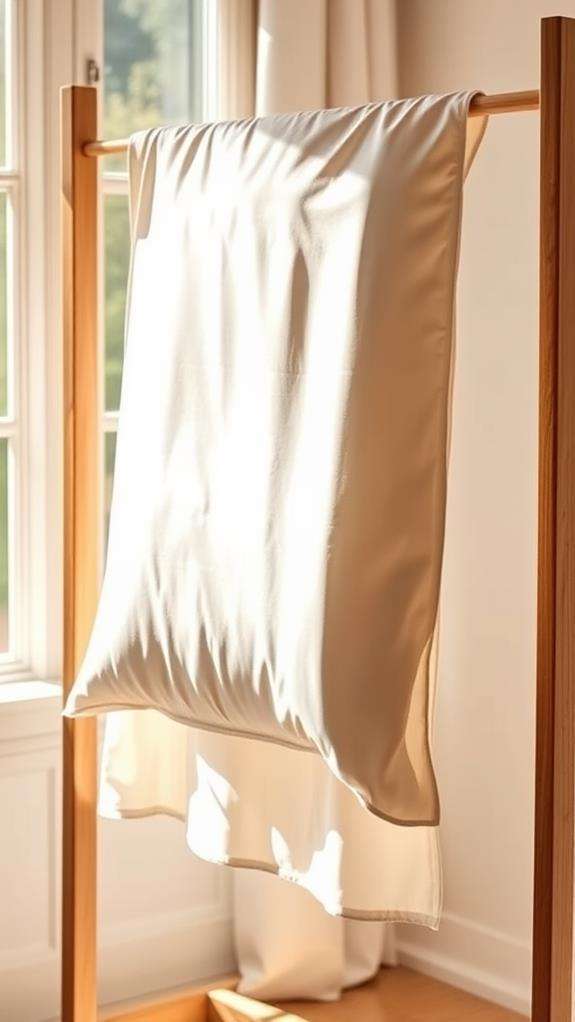
Maintaining wrinkle-free silk pillowcases requires careful attention during the drying process. To preserve your pillowcase's smooth, luxurious finish, you'll need to handle the fabric with particular care and follow specific drying techniques that prevent unwanted creases.
When it comes to preventing wrinkles while drying your silk pillowcases, here are the essential steps you'll want to follow:
- Never wring or twist the fabric, as this can damage the delicate fibers and create permanent creases
- Choose air drying over machine drying, laying the pillowcase flat or draping it over a clean towel
- Position the pillowcase away from direct sunlight when using a drying line to maintain fabric integrity
- Use soft grip clips instead of traditional clothespins to avoid leaving marks on the fabric
While your silk pillowcase is drying, take a moment to gently smooth out any visible wrinkles with your hands. This simple step helps prevent creases from setting in as the fabric dries. Remember to maintain the pillowcase's natural shape throughout the drying process by avoiding any stretching or pulling that could distort the fabric's form.
Common Drying Mistakes
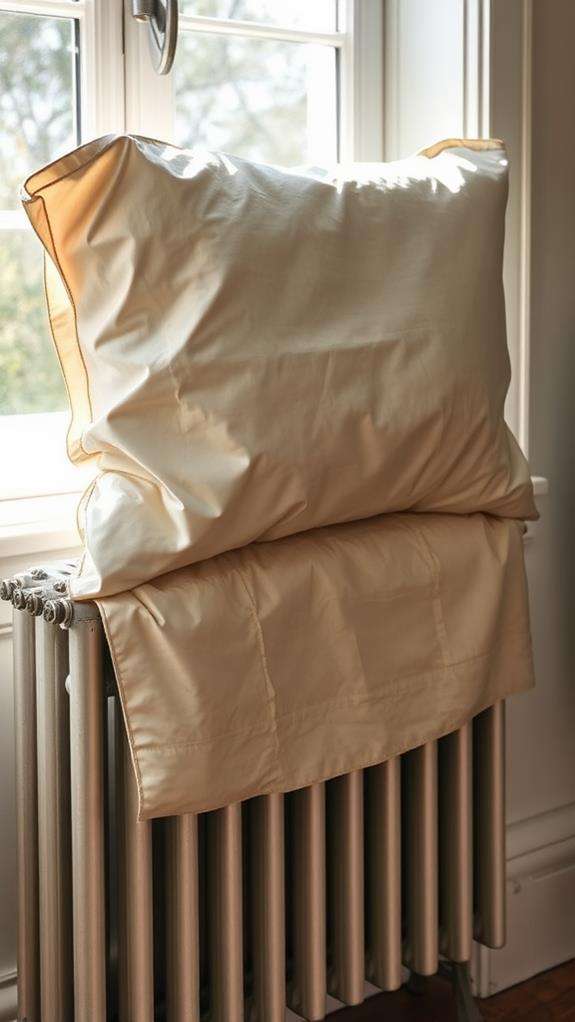
During the drying process, many people unknowingly make mistakes that can permanently damage their silk pillowcases. One of the most common drying mistakes is wringing or twisting the fabric after washing, which can severely damage the delicate fibers and alter their original shape. You'll want to avoid this practice entirely to maintain your pillowcase's integrity.
Another critical error is using your dryer, even on a low heat setting. The high temperatures inside can cause your silk to shrink and start losing luster, diminishing its luxurious appearance. Similarly, you shouldn't hang your pillowcase in direct sunlight, as this can lead to fading and weaken the fabric's structure. When using drying racks, be cautious of rough surfaces that might transfer unwanted stains or dyes onto your silk.
Perhaps the most overlooked mistake is storing your pillowcase before it's completely dry. If you put away damp silk, you're creating the perfect environment for mildew growth and musty odors. Always verify your pillowcase is thoroughly dry to the touch before storing it away, as this will help maintain its quality and extend its lifespan.
Perfect Drying Temperature
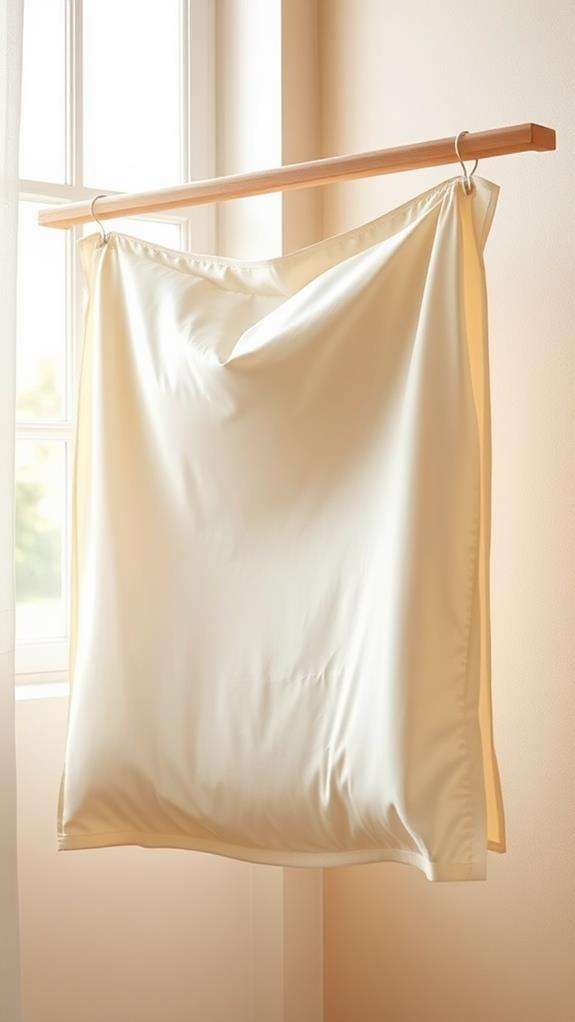
Understanding the perfect drying temperature can help you avoid the common mistakes we've discussed and keep your silk pillowcase in pristine condition. The ideal drying temperature for silk pillowcases is cool to room temperature, as anything warmer can compromise the fabric's integrity and longevity.
When drying your silk pillowcases, you'll want to focus on these key temperature-related guidelines:
- Always maintain cool to room temperature conditions, ideally between 60-75°F
- Choose a shaded area away from direct sunlight or heat sources
- Guarantee proper air circulation in your drying space
- Monitor humidity levels to prevent moisture retention
Air drying is your best option, as excessive heat from dryers can cause irreversible damage to the delicate silk fibers. If you must use a dryer, select the lowest heat setting possible, though it's strongly recommended to avoid machine drying altogether. Remember to let your silk pillowcase dry completely before using or storing it to avoid mildew development. The process might take longer than conventional drying methods, but the extra time investment will greatly extend your pillowcase's lifespan and maintain its luxurious feel.
Proper Drying Position
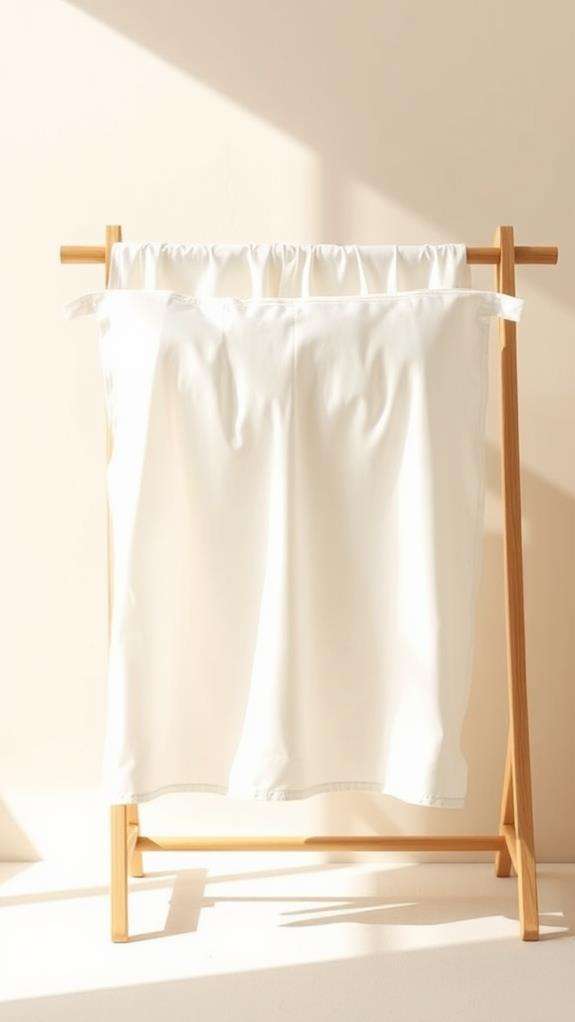
The proper drying position plays an essential role in preserving your silk pillowcase's quality and appearance. To protect your luxurious fabric, you'll want to lay your pillowcase flat on a clean, dry towel, which helps absorb excess moisture while maintaining the silk's natural shape.
When choosing your drying location, you'll need to avoid direct sunlight, as it can cause your pillowcase to fade and weaken over time. Instead, select a well-ventilated, shaded area for air drying. You've got two main options for positioning: using a drying rack or creating a flat surface with towels. If you're using a drying rack, don't pin the fabric, as this can leave unwanted marks and create permanent creases in your silk.
For the towel-drying method, you can gently roll your pillowcase inside a clean towel to help remove excess moisture. Remember to keep the fabric supported throughout the drying process to prevent stretching. As your pillowcase dries, verify there's adequate airflow around it by keeping nearby windows open or using a fan to circulate air, which will speed up the drying process naturally.
Storage After Drying
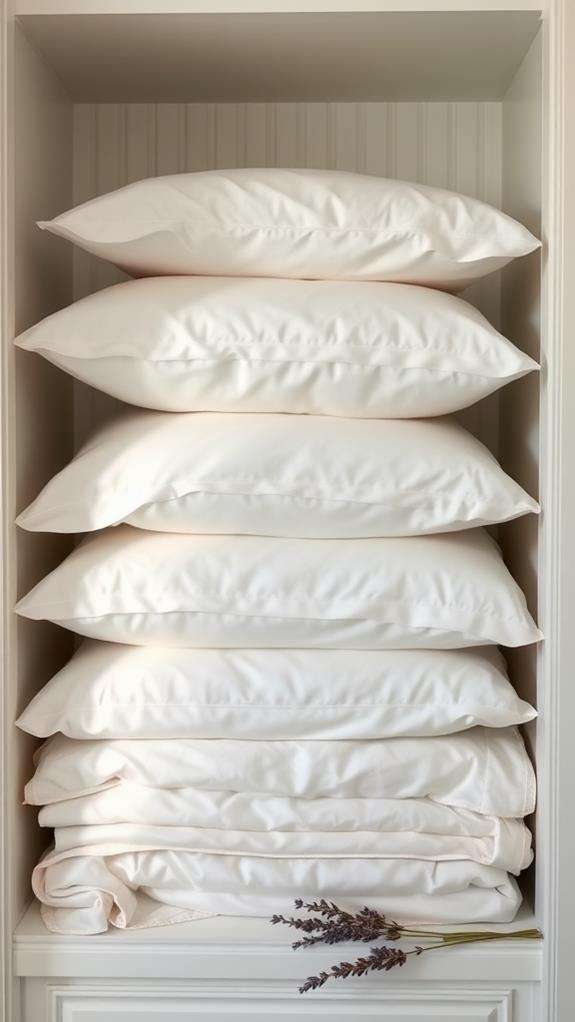
Prior to storing your silk pillowcase, you'll need to verify it's completely dry to prevent mold and mildew growth. To protect silk from damage and maintain its quality, you'll want to create ideal storage conditions that allow adequate space and proper air circulation.
When you're ready to store silk pillowcases, follow these essential guidelines:
- Place them in breathable fabric bags or mesh containers, avoiding plastic storage solutions that can trap moisture
- Position the storage area away from direct sunlight to prevent color fading and fabric deterioration
- Use wide-bar hangers or fold neatly with minimal creases to maintain the fabric's integrity
- Add natural moth repellent options like lavender sachets or cedar balls to protect silk from insects
Remember to check your stored pillowcases periodically to confirm they're maintaining proper condition. If you're storing multiple pillowcases, avoid stacking them too tightly together, as this can minimize creasing and allow proper airflow. When you need to retrieve a pillowcase, gently remove it from storage to prevent snags or tears. By following these storage practices, you'll help extend the life of your silk pillowcases and maintain their luxurious feel.
Frequently Asked Questions
Can I Put a Silk Pillowcase in the Dryer?
While you can technically put a silk pillowcase in the dryer, you shouldn't. High heat can severely damage the delicate silk fibers, causing shrinkage and dulling its natural luster. If you're in a rush and must use the dryer, select the lowest heat setting, but you'll risk shortening your pillowcase's lifespan. Instead, air dry your silk pillowcase by laying it flat or hanging it away from direct sunlight for best results.
How Long Do Silk Pillowcases Take to Dry?
Your silk pillowcase will typically take about one hour to dry completely when hung indoors or outdoors. You'll want to keep it away from direct sunlight to protect the fabric's quality. If you're looking to speed up the process, you can gently blot excess moisture with a clean, dry towel before hanging. Remember that drying time may vary depending on your room's humidity and air circulation.
How to Dry Silk Quickly?
To dry silk quickly, lay your item flat on a clean white towel and gently press out excess moisture. Roll the towel with the silk inside, applying light pressure to absorb water. Then, unroll and transfer to a fresh, dry towel, laying the silk flat. Position a fan nearby for indirect airflow, but don't aim it directly at the fabric. You'll speed up drying while protecting the delicate fibers from damage.
What Happens if You Dry Silk in the Dryer?
If you put silk in the dryer, you'll likely damage the fabric in several ways. You'll notice immediate shrinkage as the high heat disrupts the delicate fibers, and your silk item won't fit properly anymore. The dryer's heat will also dull silk's natural luster and create stubborn wrinkles that are hard to remove. Even on low heat, repeated dryer use will weaken the fibers over time, considerably shortening your silk item's lifespan.





